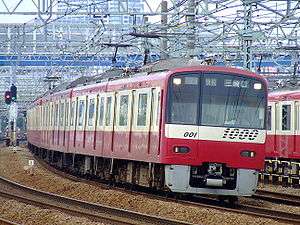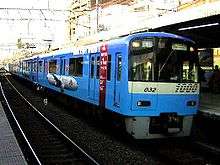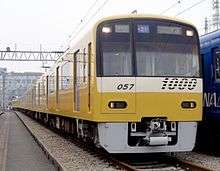Keikyu N1000 series
| Keikyu N1000 series | |
|---|---|
|
Stainless steel (left) and aluminium (right) N1000 series sets in May 2008 | |
| Manufacturer | J-TREC, Kawasaki Heavy Industries, Tokyu Car Corporation |
| Constructed | 2002– |
| Entered service | March 2002 |
| Refurbishment | 2017- |
| Number under construction | 36 vehicles (5 sets) |
| Number built | 380 vehicles (64 sets) (as of 1 April 2017) |
| Number in service | 380 vehicles (64 sets) |
| Formation | 4/6/8 cars per set |
| Operator(s) | Keikyu |
| Specifications | |
| Car body construction |
Aluminium (batches 1-5), stainless steel (batches 6 onward) |
| Car length | 18,000 mm (59 ft 1 in) |
| Width | 2,830 mm (9 ft 3 in) |
| Doors | 3 pairs per side |
| Maximum speed | 120 km/h (75 mph) |
| Traction system | Variable frequency (GTO/IGBT/PMSM) |
| Electric system(s) | 1,500 V DC overhead |
| Multiple working | 600 series, 1500 series, 2000 series, 2100 series |
| Track gauge | 1,435 mm (4 ft 8 1⁄2 in) |
The Keikyu N1000 series (京急新1000形 Keikyū Shin-1000-gata) is a DC electric multiple unit (EMU) train type operated by the private railway operator Keikyu on commuter services in the Tokyo area of Japan since 2002.[1][2]
Operations
The eight-car sets are primarily used on limited-stop "Rapid Limited Express" and "Limited Express" services on the Keikyu Main Line, including through-running services to and from the Toei Asakusa Line subway, Keisei Main Line, and Hokuso Line.[1] four-car sets are used to form 12-car "Rapid Limited Express" and "Limited Express" services, and are also used singly on all-stations "Local" services.[1] The six-car formations delivered from 2011 are generally used on all-stations "Local" services.[1] The N1000 series sets can be used in multiple with other Keikyu EMU types, including the 600 series, 1500 series, 2000 series, and 2100 series.[1]
Variants
Since the first set was introduced in March 2002, the type has undergone a number of design improvements. Sets built from 2002 to 2006 have painted aluminium bodies, whereas sets built from 2007 onward (sets 1073 onward) have unpainted stainless steel bodies. More detailed variations are described below.
Batch 1
Delivered February to June 2002.
- 8-car sets x 3: 1001, 1009, 1017
- 4-car sets x 2: 1401, 1405
These sets had single-arm pantographs and roller-blind destination indicators from new, and originally used Siemens GTO variable-frequency drive (VVVF). Eight-car set 1001 was refurbished in September 2017. Refurbishment includes the addition of LED headlights and modification to some of the passenger side windows to allow them to be opened. On December 2017, eight-car set 1017 was upgraded with LED lights and adding LCD-screens above the doors. This set still has the Siemens GTO. [3]
 1st-batch set 1001 in July 2007
1st-batch set 1001 in July 2007
Batch 2

Delivered May to July 2003.
- 8-car sets x 2: 1025, 1033
- 4-car sets x 2: 1409, 1413
The centre pillars of the passenger windows were discontinued. Set 1409 was upgraded on May 2018. It got new Toshiba IGBT, used on sets 1401 and 1405 from the earlier batch, LED lights, LCD-displays above the doors and LED-displays.
Batch 3
Delivered January to March 2005.
- 8-car sets x 2: 1041, 1049
- 4-car sets x 2: 1417, 1421
Feature IGBT variable-frequency drive.
_421.jpg) 3rd-batch 4-car set 1421 in June 2010
3rd-batch 4-car set 1421 in June 2010
Batch 4
Delivered July to August 2005.
- 8-car sets x 1: 1057
- 4-car sets x 4: 1425, 1429, 1433, 1437
Feature full-colour LED destination indicators.
- 4th-batch 4-car set 1425 in March 2008
Batch 5
Delivered November 2006.
- 8-car sets x 1: 1065
- 4-car sets x 2: 1441, 1445
No design changes over 4th batch vehicles.
- 5th-batch 4-car set 1441 with full-colour LED destination indicators in May 2008
Batch 6
Delivered March 2007.
- 8-car set x 1: 1073
Use Mitsubishi inverters. Body design changed to unpainted stainless steel. The four-seat transverse bays at the ends of cars were replaced by longitudinal bench seats.
 6th-batch 8-car set 1073 in May 2015
6th-batch 8-car set 1073 in May 2015
Batch 7
Delivered January to February 2008.
- 8-car sets x 2: 1081, 1089
Yellow warning tape was added around the door interiors.
- Stainless steel 7th-batch 8-car set 1089 in March 2008
Batch 8
Delivered September to December 2008.
- 8-car sets x3: 1097, 1105, 1113
- 4-car sets x2: 1449, 1453
Batch 9
Delivered April to June 2009.
- 4-car sets x8: 1457, 1461, 1465, 1469, 1473, 1477, 1481, 1485
Batch 10
Delivered during fiscal 2010.[4]
- 8-car sets x 3: 1121, 1129, 1137
- 4-car set x 1: 1489
Audible warnings added for door opening/closing, and pairs of LCD passenger information screens installed above doors.[5]
- 10th-batch 8-car set 1137 in July 2010
Batch 11
Delivered during fiscal 2011.[6]
- 8-car set x 1: 1145
- 6-car sets x 3: 1301, 1307, 1313
The third six-car set, 1313, entered service on 19 March 2012. This set uses LED interior lighting instead of fluorescent tubes.[7]
 11th-batch 6-car set 1313 in May 2012
11th-batch 6-car set 1313 in May 2012
Batch 12
Delivered April 2012.
- 8-car sets x1: 1153
- 6-car sets x2: 1319, 1325
- 12th-batch 6-car set 1319 in May 2012
Batch 13
Delivered August 2013 to March 2014.
- 8-car sets x1: 1161
- 6-car sets x2: 1331, 1337
 13th-batch 8-car set 1161 in June 2016
13th-batch 8-car set 1161 in June 2016
1000-1800 series
Two new 1000-1800 series four-car sets (1801 and 1805) were delivered from J-TREC in February 2016. These two sets differ from earlier variants in having centre gangways on the cab ends as well as a vinyl-based red and ivory livery.[8] These two sets entered revenue service on 4 March 2016.[9]
 Set 1801 in May 2016
Set 1801 in May 2016
Batch 16
Introduced in fiscal 2016.[10]
- 8-car sets x2 from February 2017: 1177, 1185
- 6-car sets x2 from November 2016: 1601, 1607
 Stainless-bodied 16th-batch 8-car set 1185 in May 2017
Stainless-bodied 16th-batch 8-car set 1185 in May 2017 Stainless-bodied 16th-batch 6-car set 1607 in December 2016
Stainless-bodied 16th-batch 6-car set 1607 in December 2016
Batch 17
Introduced in fiscal 2017. These sets have stainless steel bodies painted in a red and ivory livery instead of the vinyl-based livery used on earlier batches.[11] Internally, pairs of LCD passenger information screens are provided above each set of doors.[11]
- 8-car sets x3 from February 2018: 1201, 1209, 1217
- 6-car sets x2 from January 2018: 1613, 1619
Batch 18
Introduced in fiscal 2018.[11] 6-car sets x4: 1625, 1631, 1637, 1643
Formations
8-car sets 1001 to 1033
The five eight-car (aluminium bodied) sets 1001 to 1033 are formed as follows, with four motored (M) cars and four trailer (T) cars.[12]
| Designation | Muc | Tpu | Tu | Mu | Ms | Ts | Tps | Msc |
|---|---|---|---|---|---|---|---|---|
| Numbering | 1xxx | 1xxx | 1xxx | 1xxx | 1xxx | 1xxx | 1xxx | 1xxx |
The "Tpu" and "Tps" cars are each fitted with two single-arm pantographs.[12]
8-car sets 1041 to 1065
The five eight-car (aluminium bodied) sets 1041 to 1065 are formed as follows, with six motored (M) cars and two trailer (T) cars.[12]
| Designation | Muc | Tpu | M2u | M1u | M1s | M2s | Tps | Msc |
|---|---|---|---|---|---|---|---|---|
| Numbering | 1xxx | 1xxx | 1xxx | 1xxx | 1xxx | 1xxx | 1xxx | 1xxx |
The "Tpu" and "Tps" cars are each fitted with two single-arm pantographs.[12]
8-car sets 1073 to 1145
The ten eight-car (stainless steel bodied) sets 1073 to 1145 are formed as follows, with six motored (M) cars and two trailer (T) cars.[12]
| Designation | M2uc | M1u | Tu | M1u' | M2s | Ts | M1s | M2sc |
|---|---|---|---|---|---|---|---|---|
| Numbering | 1xxx | 1xxx | 1xxx | 1xxx | 1xxx | 1xxx | 1xxx | 1xxx |
The "M1u" and "M1s" cars are each fitted with two single-arm pantographs, and the "M1u'" are fitted with one pantograph.[12]
6-car sets 1301 to 1313
The three six-car (stainless steel bodied) sets 1301 to 1313 are formed as follows, with four motored (M) cars and two trailer (T) cars.[12]
| Designation | M2uc | M1u | Tu | Ts | M1s | M2sc |
|---|---|---|---|---|---|---|
| Numbering | 13xx | 13xx | 13xx | 13xx | 13xx | 13xx |
The "M1u" and "M1s" cars are each fitted with two single-arm pantographs.[12]
4-car sets 1401 to 1405
The two four-car (aluminium bodied) sets 1401 to 1405 are formed as follows, with two motored (M) cars and two trailer (T) cars.[12]
| Designation | Muc1 | Tpu1 | Tps1 | Msc1 |
|---|---|---|---|---|
| Numbering | 14xx | 14xx | 14xx | 14xx |
The "Tpu1" and "Tps1" cars are each fitted with one single-arm pantograph.[12]
4-car sets 1409 to 1413
The two four-car (aluminium bodied) sets 1409 to 1413 are formed as follows, with two motored (M) cars and two trailer (T) cars.[12]
| Designation | Muc1 | T | Tp | Msc1 |
|---|---|---|---|---|
| Numbering | 14xx | 14xx | 14xx | 14xx |
The "Tp" cars are fitted with two single-arm pantographs.[12]
4-car sets 1417 to 1445
The eight four-car (aluminium bodied) sets 1417 to 1445 are formed as follows, with three motored (M) cars and one trailer (T) car.[12]
| Designation | Muc1 | M2 | Tp | Msc1 |
|---|---|---|---|---|
| Numbering | 14xx | 14xx | 14xx | 14xx |
The "Tp" cars are fitted with two single-arm pantographs.[12]
4-car sets 1449 to 1489
The eleven four-car (stainless steel bodied) sets 1449 to 1489 are formed as follows, with four motored (M) cars.[12]
| Designation | M2uc | M1u | M1s | M2sc |
|---|---|---|---|---|
| Numbering | 14xx | 14xx | 14xx | 14xx |
The "M1u" and "M1s" cars are each fitted with one single-arm pantograph.[12]
Livery variations

8-car set 1057 was repainted into a special "Yellow Happy Train" livery from May 2014.[13]
References
- 1 2 3 4 5 私鉄車両年鑑 2012: 大手15社営業用車両完全網羅 私鉄車両年鑑2012 [Japan Private Railways Annual 2012]. Tokyo, Japan: Ikaros Publications Ltd. February 2012. p. 123. ISBN 978-4-86320-549-9.
- ↑ Keikyu N1000 series Archived 25 December 2008 at the Wayback Machine.. Retrieved 17 September 2008. (in Japanese)
- ↑ 京急 新1000形更新車が営業運転を開始 [Refurbished Keikyu New 1000 series enters revenue service]. Japan Railfan Magazine Online (in Japanese). Japan: Koyusha Co., Ltd. 22 September 2017. Archived from the original on 29 September 2017. Retrieved 29 September 2017.
- ↑ 私鉄車両編成表 私鉄車両編成表 2011 [Private Railway Rolling Stock Formations - 2011]. Japan: Kotsu Shimbunsha. July 2011. p. 42. ISBN 978-4-330-22711-5.
- ↑ 京浜急行電鉄 新1000形10次車 [Keikyu N1000 series 10th-batch cars]. Japan Railfan Magazine. Vol. 50 no. 592. Japan: Koyusha Co., Ltd. August 2010. p. 69.
- ↑ 京急1000形でLED照明を本採用 [LED lighting used on Keikyu 1000 series]. Japan Railfan Magazine. Vol. 52 no. 614. Japan: Koyusha Co., Ltd. June 2012. pp. 84–85.
- ↑ 京浜急行電鉄 新1000形(11次車) [Keikyu New 1000 series (11th batch unit)]. Tetsudō Daiya Jōhō Magazine. Vol. 41 no. 337. Japan: Kotsu Shimbun. May 2012. p. 75.
- ↑ 京急 新1000形1800番台が総合車両製作所から出場 [Keikyu New 1000 series 1800 subseries delivered from J-TREC]. Japan Railfan Magazine Online (in Japanese). Japan: Koyusha Co., Ltd. 25 February 2016. Retrieved 25 February 2016.
- ↑ 京急 新1000形1800番台が営業運転を開始 [Keikyu New 1000 series 1800 subseries enter service]. Japan Railfan Magazine Online (in Japanese). Japan: Koyusha Co., Ltd. 5 March 2016. Retrieved 5 March 2016.
- ↑ 京浜急行電鉄新1000形16次車 [Keikyu New 1000 series 16th-batch EMUs]. Japan Railfan Magazine (in Japanese). Vol. 57 no. 670. Japan: Koyusha Co., Ltd. February 2017. p. 61.
- 1 2 3 京急新1000形17次車 2018年春導入へ [Keikyu New 1000 series 17th batch trainsets to be introduced in spring 2018]. Tetsudo Hobidas (in Japanese). Japan: Neko Publishing Co., Ltd. 30 November 2017. Archived from the original on 1 December 2017. Retrieved 1 December 2017.
- 1 2 3 4 5 6 7 8 9 10 11 12 13 14 15 16 私鉄車両編成表 2012 [Private Railway Rolling Stock Formations - 2012]. Japan: Kotsu Shimbunsha. July 2012. p. 42. ISBN 978-4-330-29911-2.
- ↑ ""KEIKYU YELLOW HAPPY TRAIN"運行開始" [Keikyu Yellow Happy Train in service]. Tetsudo Hobidas (in Japanese). Japan: Neko Publishing. 30 April 2014. Retrieved 18 July 2014.
External links
| Wikimedia Commons has media related to Keikyu N1000 series. |
- Keikyu N1000 series information (in Japanese)
- Kawasaki Heavy Industries product information (in Japanese)
- Siemens order information
